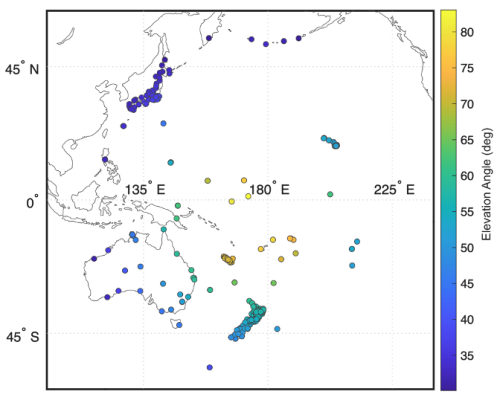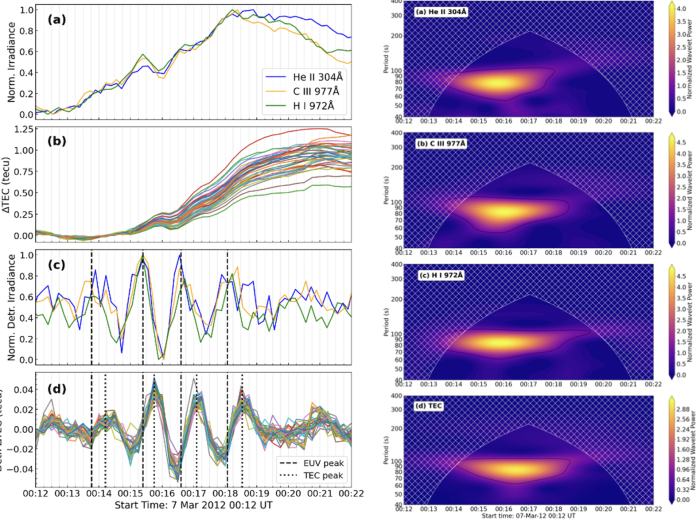Quasi-Periodic Pulsations in Ionospheric TEC and Flare EUV
| Nugget | |
|---|---|
| Number: | 493 |
| 1st Author: | Aisling O'HARE |
| 2nd Author: | |
| Published: | April 21, 2025 |
| Next Nugget: | |
| Previous Nugget: | Metis observations of Alfvenic outflows driven by interchange reconnection in a pseudostreamer |
Introduction
It is well known that emission from solar flares significantly increases the electron density of the Earth's ionosphere. Solar flares generally involve drastic variability, including an "impulsive phase" in which non-thermal effects dominate. There are also quasi-periodic variations on a variety of time scales, which we refer to as QPPs (quasi-periodic pulsations). While the dramatic impacts of the impulsive phase of flares on ionospheric electron density have been studied extensively, our investigation presents a new discovery: a link between quasi-periodic pulsations (QPPs) in solar flare extreme ultraviolet (EUV) emission and pulsations in ionospheric total electron content (TEC).
QPPs are generally described as regular pulsations or fluctuations in solar flare emission that have a periodic or characteristic timescale. They are widely observed across a range of wavelengths during flares. Previously, pulsations in X-ray flare emission were linked to similar oscillatory behaviour in the D-region of the Earths ionosphere using VLF (very low frequency) radio measurements (Ref. [1]). Our study (Ref. [2]) is the first to show that small-scale EUV pulsations can induce a measurable response in TEC, which probes the E- and F-regions of the ionosphere.
Data
We analysed three EUV emission lines - He II 304Å , H I 972Å, and C III 977Å as observed by SDO/EVE during the GOES X5.4 flare SOL2012-03-07 (Figure 1). These lines were chosen based on the results of theoretical models of the Earth's ionosphere (e.g. Ref. [3]). The data were detrended to highlight QPPs during the impulsive phase of this flare. TEC measurements from 251 ground-based GNSS stations across the dayside of the Earth (Figure 2) were processed using the same detrending approach to reveal pulsating behaviour similar to that of the EUV QPPs (Figure 3).


Cross correlation analysis revealed that a 30-second delay yielded the highest correlation coefficients (r) between the solar and ionospheric pulsations: r = 0.78 for He II 304Å, r = 0.88 for C III 977Å, and r = 0.83 for H I 972Å. These strong correlations indicate a robust link between solar QPPs and ionospheric TEC variations. Wavelet (Figure 4) and periodogram analyses confirmed a common periodicity of ~85 seconds across all three EUV lines and the TEC data.

Conclusion
The connection we have made demonstrates that the ionosphere is sensitive not only to the overall intensity of solar flares, but also to their small-scale temporal structure. Our findings allow new inferences about the geoeffectiveness of individual EUV wavelengths, based on their correlation with ionospheric TEC fluctuations. The observed 30-second time delay between the solar and ionospheric pulsations is only the second report of such a delay and could provide a basis for estimating recombination rates in the F-region, similar to how D-region rates are inferred from VLF signal delays.
References
[1] "Pulsations in the Earth's lower ionosphere synchronized with solar flare emission"
[2] "Quasi-Periodic Pulsations in Ionospheric TEC Synchronized with Solar Flare EUV Emission"